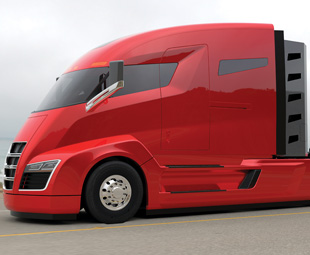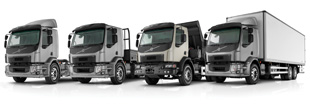Is Nikola One the future of long-distance trucking?

In his monthly review of global news for local truckers, FRANK BEETON takes a look at an important new direction for line-haul trucking, revives the Ford Cargo story with new developments, and discovers an interesting twist that almost changed Volvo’s South American strategy
To most people, the name “Tesla” relates to the Californian-based company that builds and sells electric cars, and is associated with South African-born entrepreneur Elon Musk. However, the name actually derives from Nikola Tesla, a Siberian-American inventor, electrical engineer, mechanical engineer, physicist and futurist, who lived from 1856 to 1943.
According to Wikipedia, he was best known for his contribution to the design of the modern alternating-current electricity supply system. He was also famous for his showmanship, with a reputation for being something of a “mad scientist”, but he eventually earned immortality when the General Conference on Weights and Measures named the SI unit of magnetic flux density the “tesla”, in his honour.
It was, therefore, understandable that Tesla Motors would adopt his name for their innovative and pioneering foray into electric car manufacture and marketing. However, when an American visionary, Trevor Milton, decided some years ago to leave the position of CEO at the natural-gas storage technology company, dHybrid Systems, and start his own business in Utah, in the United States of America (USA), to design and manufacture electric vehicles, energy storage systems and electric-vehicle drivetrain components, he tapped the other half of Tesla’s name and called it the Nikola Motor Company.
During May, Nikola revealed details of the Nikola Zero, a four-seat 388 kW (520 hp) 4×4 electric utility task vehicle, and (of greater interest to readers this column) the Nikola One – a most intriguing pioneering design for a line-haul truck-tractor. At this point, neither vehicle exists “in the metal”, with working prototypes still under construction, but the Nikola One concept is of considerable interest.
Nicola One emerges
The initial published renderings of Nikola One reveal a sleek three-axle prime mover, with a cab layout that could be termed semi-forward control, and not the long-bonneted conventional design so enamoured of American truckers.
 This is an interesting choice in itself, as some observers have recently put forward the view that short-nosed truck cabs could become the universal choice in years to come, and rule out the disparity in truck design that has made it necessary for manufacturers to keep unique North American products alive, while much of the world considers forward control (cabover) to be the most cost-effective configuration. The Nikola cab is claimed to be 30-percent larger than the current norm, and to be highly efficient in terms of aerodynamic shape.
This is an interesting choice in itself, as some observers have recently put forward the view that short-nosed truck cabs could become the universal choice in years to come, and rule out the disparity in truck design that has made it necessary for manufacturers to keep unique North American products alive, while much of the world considers forward control (cabover) to be the most cost-effective configuration. The Nikola cab is claimed to be 30-percent larger than the current norm, and to be highly efficient in terms of aerodynamic shape.
However, it is the technical specification that really sets Nikola One apart from the current truck design norm. First, the series-hybrid drivetrain works through six individual electric-wheel motors delivering a collective output of more than 1 490 kW (2 000 hp), and 5 016 Nm of torque.
Electrical power is drawn from a liquid-cooled 320 kWh lithium-ion battery pack, which is recharged by a 400 kW gas turbine charger, plus regenerative power returned from the wheel motors when they are employed in the retardation mode. The turbine is described as “fuel agnostic”, implying that it can run on petrol, diesel or natural gas.
A potential game changer?
This 6×6 driveline configuration removes the need for conventional gearbox, propeller shaft, differential or axle fitment, with a resultant saving in tare mass. Electronic control of the speed and torque of each individual wheel motor enables “torque vectoring”, which optimises cornering, retardation, traction and tyre life.
 The battery pack is also used to power the cab’s full-sized refrigerator/freezer, climate control, infotainment display, microwave oven and television. Nikola claims that running costs will be roughly half of those incurred by a conventional diesel truck.
The battery pack is also used to power the cab’s full-sized refrigerator/freezer, climate control, infotainment display, microwave oven and television. Nikola claims that running costs will be roughly half of those incurred by a conventional diesel truck.
The design incorporates a unique all-round independent suspension system, developed in conjunction with automotive component supplier Meritor, which is intended to provide a high level of driver comfort. The gross combination mass (GCM) rating is typical of a US Class-8 truck tractor at 36 t.
There can be no doubt that, if it lives up to its originator’s claims, Nikola One has the potential to severely shake up the line-haul truck market. While the original design is very specifically aimed at North American operators, there is no good reason why the same principles should not be applicable elsewhere, and the electrical nature of its systems should fit well with autonomous vehicle thinking.
Nikola Motor Company is also advocating the operation of Nikola One in “fleet convoy and virtual hitch” with up to six rigs running in close-coupled convoy (which equates to the topical platooning philosophy). Production of this revolutionary product is planned to commence at Nikola’s Utah plant within 24 to 36 months.
MORE NEW FORD CARGO TRUCKS FOR ARGENTINA
The watching brief that we maintain on the South American truck and bus scene continues to deliver stories of considerable interest. Back in 2011, we started following news of Ford’s new Brazilian Cargo truck range, which eventually led to linked stories in such diverse areas of the world as Turkey and China.
As we had anticipated, there has been no massive global revival of Ford’s formerly extensive heavy truck involvement, but rather a steady roll-out of products into selected markets, notably in South America.
 We recently read of a range expansion for Cargo in Argentina, which has given us some additional insight into that product line-up.
We recently read of a range expansion for Cargo in Argentina, which has given us some additional insight into that product line-up.
The original eleven-model Brazilian New Cargo range was powered by Cummins ISBe4, ISBe6 and ISC diesels ranging from 125 to 235 kW (170 to
320 hp), rather than Ford’s own nine-litre Ecotorq diesel employed in the Turkish equivalent, presumably in accordance with South American market preferences.
The South American range included 4×2, 6×2 and 6×4 configurations, covering the gross vehicle mass (GVM) spectrum from 13 to 23 t, with GCM ratings up to 56 t. The driveline specification was completed by Eaton six-, eight- and 12-speed transmissions and Arvin Meritor drive axles.
The importance of the Brazilian market, and those of its neighbouring Latin American nations, can be gauged by the fact that global truck and bus manufacturers are fully prepared to develop unique products specifically for manufacture and sale in that region.
The Brazilian market alone for commercial vehicles over 3,5 t GVM was historically worth around 150 000 units per annum, but recent economic tribulations dragged that down to 71 655 units in 2015.
New Cargo variants
Notwithstanding the reduced demand, Ford has continued to develop and expand the Cargo range. Late in 2013, it introduced two new truck-tractor models, designated 2042 and 2842, to the Brazilian market.
These differed from previous Cargo models in being equipped with 309 kW (420 hp) FPT (Iveco) Cursor engines, thus deviating from the policy of using Cummins engines to power the range up to that point.
The 2042 (4×2) and 2842 (6×2) are rated at GCM ratings of 49 and 56 t, respectively, and both are equipped with 12-speed automated ZF Astronic transmissions. Standard equipment includes ASR automatic traction control, ABS braking with EBD, with electronic stability control optional on the 2842.
In response to the implementation of the Euro-6 emission standard in Argentina on January 1, Ford Argentina added these two models to its previous eight model Cargo line-up.
It is very difficult to imagine how far Ford will go, in a global sense, with the New Cargo range, but its commitment in providing a comprehensive medium/heavy truck product line-up to its selected target markets has been impressive.
The engine selections – which now include Cummins and Fiat-family FPT units in South America, Ford’s own Ecotorq in Turkey, and licence-built Ecotorq power units produced by the joint venture with Jiangling in China – indicate a high degree of flexibility in thinking.
However, the faltering economy and vehicle market in Brazil, which has inevitably led to under-utilised production capacity, may be good cause to consider exploiting additional new markets for the models built there.
VOLVO DROPS PLANS FOR SECOND BRAZILIAN BRAND
The Brazilian economic woes have had another interesting outcome. According to reports in the overseas media, the Volvo Group was planning to introduce a second truck brand in Brazil; to offer a simpler, lighter and more affordable range alternative to the premium and technologically advanced Volvo line-up.
However, the recent market collapse, which resulted in losses for Volvo do Brazil, and underutilised capacity at the company’s recently modernised Curitiba plant, have reportedly caused the cancellation of these plans.
Back in 2013, we reported extensively on Volvo’s fourth-generation VM range for Brazil and Latin America. This was a forward-control (cabover) truck, available in 4×2, 6×2, 6×4, 8×2 or 8×4 configurations, with GVM ratings up to 29 t.
We noted the extensive utilisation of bought-in components in the VM execution, including diesel engines ranging from 164 kW (220 hp) to
246 kW (330 hp) from MWM International Motores (a Navistar group company), six-, nine- and ten-speed transmissions from Eaton, Meritor rear axles, and Brazilian-manufactured SIFCO front axles.
The historical importance of the South American market in volume terms, and its unique operational characteristics, justified the use of outsourced proprietary components that were acceptable to the local operating community.
However, the cost benefits of using these locally procured components clearly did not fully satisfy Volvo’s marketing objectives, hence the plans to create a more basic product for Brazil, and presumably, South America.
A South American opportunity for Eicher?
In our 2014 assessment of global truck manufacturers, we said inter alia: “The (Volvo) Group’s main issue, going forward, appears to be over-concentration by its principal brands at the upper end of the payload spectrum … and alternative sources for entry-level products, such as Eicher in India and Dongfeng in China, are coming more sharply into focus”.
We have not read that either Eicher or Dongfeng products were under consideration for the South American strategy, but we had heard that Eicher was on the planning horizon for South Africa up to the end of 2015. There has been no further news since then, so we can only imagine that the Group’s subsequent absence from the local medium commercial vehicle (MCV) market segment is the result of some obstacle that subsequently emerged.
Volvo’s potential global truck industry leadership position, which emerged as a serious possibility once the partnership deal around Dongfeng Commercial Vehicles was finalised, still has some work ahead. This will include reducing the product concentration mentioned above.
If we look at the situation in South Africa as a microcosm of the global situation, the Volvo Group enjoyed an 18,3 percent reported share of the total market over 3,5 t GVM in 2014, the last year in which UD’s U41 MCV range was fully available, and a broader range of Renault trucks was on offer. Since then, U41 has run out, and Renault has been repositioned as a specialist construction-vehicle brand.
During the first quarter of 2016, and despite a very strong recent showing by Volvo and UD’s EHCV models, the Volvo Group’s overall market share had declined to 15,8 percent.
It should also be noted that the Group’s strong current participation in the cruiserweight heavy commercial vehicle (HCV) segment of the local market is totally dependent on UD products, so it is imperative that consolidation of its market share will hinge on continued availability of these models, suitably updated to follow market demands, or, alternatively, a fully competitive replacement range.
Global FOCUS is a monthly update of international news relating to the commercial vehicle industry. It is compiled exclusively for FOCUS by Frank Beeton of Econometrix.
Published by
Focus on Transport
focusmagsa




